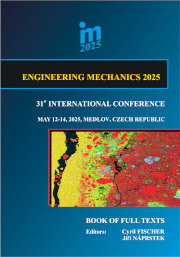Proceedings Vol. 31 (2025)

ENGINEERING MECHANICS 2025
May 12 – 14, 2025, Medlov, Czech Republic
All papers were reviewed by members of the scientific committee.
ISBN 978-80-86246-99-4 (electronic)
ISSN 1805-8248 (printed)
ISSN 1805-8256 (electronic)
scientific committee — home
Chapter 5: Advances in Fracture Mechanics
Safety is the most important value in aviation. However, an aircraft incident may occur. Sometimes, during operation or maintenance, new, previously unknown degradation effects can be observed and need to be tested or analysed in the shortest possible time. This article describes the advanced laboratory mechanical testing of turbine blades, combined with a data classification process, offering a way to find the root cause of some specific fatigue damage and thus contribute to increased operational safety.
Multiscale homogenization enables the calculation of the macroscopic stress response of a discrete periodic representative volume element (RVE) of a (quasi) brittle materials subjected to a macroscopic strain, accurately capturing their nonlinear inelastic behaviour. Wider application of the RVE as a microstructural constitutive model is hindered by its high computational cost. This paper investigates two data-driven approaches to approximate the effective response of the RVE. 3D RVE is loaded by uniaxial macroscopic strain and the response is approximated using polynomial chaos expansion (PCE) and neural networks. Both approaches incorporate a predefined history variable to incorporate the path dependency, while the second also tries to leverage recurrent neural networks (RNNs) to learn the load path dependency autonomously. The results show that the RNN can reach the same accuracy as a feed-forward network with a history variable given enough training data. The PCE provides good results but does not reach the precision of the other methods.
Copyright © 2025 Institute of Theoretical and Applied Mechanics, Czech Academy of Sciences, Prague
All contributions are published under the Creative Commons Attribution 4.0 International License (CC BY 4.0). The copyright remains with the authors. The texts are publicly accessible, and any reuse must include appropriate credit to the original source as required by the license.
